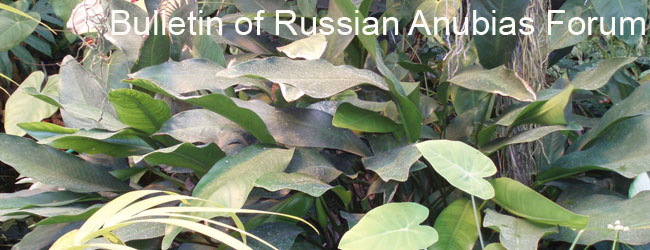 I’m sure that you heard about cactuses’ thorns or roses’ prickles, so it can’t surprise you, but such emergences among aquarian plants are very seldom. First of all we should define such words as “thorns” and “prickles”. Thorns are hard acuminate emergences of plants; they appear as the result of the stem, leaf, root or their parts’ metamorphosis. Prickles are strong, acerous emergences of the plants’ epidermis. Not long ago we noticed that some species of Anubias have small (up to 2 mm in length) mucronated emergences on the petioles. Taking into consideration their size and location we can say that in our case we deal with prickles.
I’m sure that you heard about cactuses’ thorns or roses’ prickles, so it can’t surprise you, but such emergences among aquarian plants are very seldom. First of all we should define such words as “thorns” and “prickles”. Thorns are hard acuminate emergences of plants; they appear as the result of the stem, leaf, root or their parts’ metamorphosis. Prickles are strong, acerous emergences of the plants’ epidermis. Not long ago we noticed that some species of Anubias have small (up to 2 mm in length) mucronated emergences on the petioles. Taking into consideration their size and location we can say that in our case we deal with prickles.
For the first time we found such prickles accidentally, when we “weeded out” greenhouse with the large species among which was also Anubias heterophylla. The petioles of this Anubias were covered with small pr
 ickles; they were so edgy that you could easily scratch your hands. Then we check all adult bushes of more than 30 Anubias’ species and their varieties and found out that such emergences have Anubias afzelii, A. gilletii, A. heterophylla ‘Spathulata’, A. ‘Frazeri’ и A. barteri var.caladiifolia ‘Variegated’. We should mention once more, that only adult bushes have such prickles on the petioles (2-3 years old bushes, which were grown up in greenhouse conditions) and such unusual emergences are situated along the full length of the petioles, but there are more of them in the lower part. Young plants of the noted species have absolutely smooth petioles.
ickles; they were so edgy that you could easily scratch your hands. Then we check all adult bushes of more than 30 Anubias’ species and their varieties and found out that such emergences have Anubias afzelii, A. gilletii, A. heterophylla ‘Spathulata’, A. ‘Frazeri’ и A. barteri var.caladiifolia ‘Variegated’. We should mention once more, that only adult bushes have such prickles on the petioles (2-3 years old bushes, which were grown up in greenhouse conditions) and such unusual emergences are situated along the full length of the petioles, but there are more of them in the lower part. Young plants of the noted species have absolutely smooth petioles.
Prickles of A. heterophylla 'Spathulata':

Practically there is no information about Anubias’ prickles in the literature. Christel Kasselmann noted in her book “Aquarium Plants” that Anubias gilletii, A.hastifolia and A. pynaertii had such emergencies. Also Josef Bogner with other co-authors wrote about Anubias’ prickles in the article concerning the family Araceae from the forth volume of the encyclopedia “The Families and Genera of Vascular Plants” (2006), but without any concretization of species. And there is no information concerning the role of these prickles.
But plants’ thorns and prickles have a biological meaning; first of all it’s a defense from animals and decrease of transpiration (plants of arid region). The Anubias prickles aren’t connected with the tendency to decrease evaporating surface, perhaps it’s only the defense from herbivores. We haven’t any information whether this plant is a nutritive base for the mammals at the places of their natural growth, but many times we observed, that these Araceae become the dainty dish for usual greenflies. Indirectly it proves that the tissues of these plants don’t contain any high-toxic substances and as opposed to Aglaonema and Dieffenbachia, which belong to the same family, they can be eatable. For reasons given we make a conclusion that Anubias’ prickles can be a sign of the plants’ zoophobia.
The prickles which we observe are declinate a bit and practically similar with roses thorns. In connection with this we can single out one more function of these emergencies – clutch at support and stand in grass, it’s very important in condition of the intense competition for sunlight in thick tropical forest. This reason for the presence of the prickles is more probable.
Petioles of A. afzelii:

Anubias are one of the mysterious plants in aquarium and we are sure, that in the future they will spring many surprises on their owners.
The authors of this note: Dmitry Loginov and Sergey Gerasimov.
The note is based on the next article: D. Loginov, S. Gerasimov “Anubias prickles”, Russian Journal “Aquarium”, 2009, № 3.
Translated from Russian by Julia Niklyaeva and Alexander Grigorov







